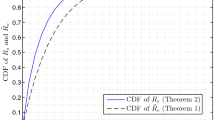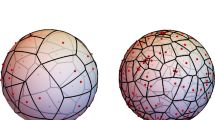Abstract
We perturb the simple cubic (SC), body-centered cubic (BCC), and face-centered cubic (FCC) structures with a spatial Gaussian noise whose adimensional strength is controlled by the parameter α and analyze the statistical properties of the cells of the resulting Voronoi tessellations using an ensemble approach. We concentrate on topological properties of the cells, such as the number of faces, and on metric properties of the cells, such as the area, volume and the isoperimetric quotient. The topological properties of the Voronoi tessellations of the SC and FCC crystals are unstable with respect to the introduction of noise, because the corresponding polyhedra are geometrically degenerate, whereas the tessellation of the BCC crystal is topologically stable even against noise of small but finite intensity. Whereas the average volume of the cells is the intensity parameter of the system and does not depend on the noise, the average area of the cells has a rather interesting behavior with respect to noise intensity. For weak noise, the mean area of the Voronoi tessellations corresponding to perturbed BCC and FCC perturbed increases quadratically with the noise intensity. In the case of perturbed SCC crystals, there is an optimal amount of noise that minimizes the mean area of the cells. Already for a moderate amount of noise (α>0.5), the statistical properties of the three perturbed tessellations are indistinguishable, and for intense noise (α>2), results converge to those of the Poisson-Voronoi tessellation. Notably, 2-parameter gamma distributions constitute an excellent model for the empirical pdf of all considered topological and metric properties. By analyzing jointly the statistical properties of the area and of the volume of the cells, we discover that also the cells shape, measured by the isoperimetric quotient, fluctuates. The Voronoi tessellations of the BCC and of the FCC structures result to be local maxima for the isoperimetric quotient among space-filling tessellations, which suggests a weaker form of the recently disproved Kelvin conjecture. Moreover, whereas the size of the isoperimetric quotient fluctuations go to zero linearly with noise in the SC and BCC case, the decrease is quadratic in the FCC case. Correspondingly, anomalous scaling relations with exponents larger than 3/2 are observed between the area and the volumes of the cells for all cases considered, and, except for the FCC structure, also for infinitesimal noise. In the Poisson-Voronoi limit, the exponent is ∼1.67. The anomaly in the scaling indicates that large cells preferentially feature large isoperimetric quotients. The FCC structure, in spite of being topologically unstable, results to be the most stable against noise when the shape—as measured by the isoperimetric quotient—of the cells is considered. These scaling relations apply only for a finite range and should be taken as descriptive of the bulk statistical properties of the cells. As the number of faces is strongly correlated with the sphericity (cells with more faces are bulkier), the anomalous scaling is heavily reduced when we perform power law fits separately on cells with a specific number of faces.
Similar content being viewed by others
References
Ashcroft, N.W., Mermin, N.D.: Solid State Physics. Saunders, Philadelphia (1976)
Aurenhammer, F.: Voronoi diagrams—a survey of a fundamental geometric data structure. ACM Comput. Surv. 23, 345–405 (1991)
Averill, F.W., Painter, G.S.: Pseudospherical integration scheme for electronic-structure calculations. Phys. Rev. B 39, 8115 (1989)
Barber, C.B., Dobkin, D.P., Huhdanpaa, H.T.: The quickhull algorithm for convex hulls. ACM Trans. Math. Softw. 22, 469–483 (1996)
Barrett, T.M.: Voronoi tessellation methods to delineate harvest units for spatial forest planning. Can. J. For. Res. 27(6), 903–910 (1997)
Bassani, F., Pastori-Parravicini, G.: Electronic States and Optical Transitions in Solids. Pergamon, Oxford (1975)
Bennett, L.H., Kuriyama, M., Long, G.G., Melamud, M., Watson, R.E., Weinert, M.: Local atomic environments in periodic and aperiodic Al-Mn alloys. Phys. Rev. B 34, 8270–8272 (1986)
Bowyer, A.: Computing Dirichlet tessellations. Comput. J. 24, 162–166 (1981)
Calka, P.: Precise formulae for the distributions of the principal geometric characteristics of the typical cells of a two-dimensional Poisson Voronoi tessellation and a Poisson line process. Adv. Appl. Probab. 35, 551–562 (2003)
Christ, N.H., Friedberg, R., Lee, T.D.: Random lattice field theory: general formulation. Nucl. Phys. B 202, 89–125 (1982)
Coles, S.G.: An Introduction to Statistical Modeling of Extreme Values. Springer, London (2001)
Desch, C.H.: The solidification of metals from the liquid state. J. Inst. Met. 22, 241 (1919)
Dotera, T.: Cell crystals: Kelvin’s polyhedra in block copolymer melts. Phys. Rev. Lett. 82, 105–108 (1999)
Drouffe, J.M., Itzykson, C.: Random geometry and the statistics of two-dimensional cells. Nucl. Phys. B 235, 45–53 (1984)
Du, Q., Wang, D.: The optimal centroidal Voronoi tessellations and the Gersho’s conjecture in the three dimensional space. Comput. Math. Appl. 49, 1355–1373 (2005)
Entezari, A., Van De Ville, D., Möller, T.: Practical box splines for reconstruction on the body centered cubic lattice. IEEE Trans. Vis. Comput. Graph. 14, 313–328 (2008)
Finch, S.R.: Unpublished. Available on http://algo.inria.fr/csolve/vi.pdf. (2005). Addendum to Finch S.R.: Mathematical Constants. Cambridge University Press, Cambridge (2003)
Finney, J.L.: Volume occupation, environment and accessibility in proteins. The problem of the protein surface. J. Mol. Biol. 96, 721–732 (1975)
Goede, A., Preissner, R., Frömmel, C.: Voronoi cell: new method for allocation of space among atoms: elimination of avoidable errors in calculation of atomic volume and density. J. Comput. Chem. 18, 1113–1118 (1997)
Hales, T.C.: A proof of the Kepler conjecture. Ann. Math. 162, 1065–1185 (2005)
Han, D., Bray, M.: Automated Thiessen polygon generation. Water Resour. Res. 42, W11502 (2006). doi:10.1029/2005WR004365
Hentschel, H.G.E., Ilyin, V., Makedonska, N., Procaccia, I., Schupper, N.: Statistical mechanics of the glass transition as revealed by a Voronoi tessellation. Phys. Rev. E 75, 50404(R) (2007)
Hilhorst, H.J.: Asymptotic statistics of the n-sided planar Poisson–Voronoi cell: I. Exact results. J. Stat. Mech. (2005). P09005 doi:10.1088/1742-5468/2005/09/P09005
Hinde, A.L., Miles, R.E.: Monte Carlo estimates of the distributions of the random polygons of the Voronoi tessellation with respect to a Poisson process. J. Stat. Comput. Simul. 10, 205–223 (1980)
Hug, D., Schneider, R.: Typical cells in Poisson hyperplane tessellations. Discrete Comput. Geom. 38, 305–319 (2007)
Hug, D., Reitzner, M., Schneider, R.: The limit shape of the zero cell in a stationary Poisson hyperplane tessellation. Ann. Probab. 32, 1140–1167 (2004)
Icke, V.: Particles, space and time. Astrophys. Space Sci. 244, 293–312 (1996)
Karch, R., Neumann, M., Neumann, F., Ullrich, R., Neumüller, J., Schreiner, W.: A Gibbs point field model for the spatial pattern of coronary capillaries. Physica A 369, 599–611 (2006)
Kovalenko, I.N.: Proof of David Kendall’s conjecture concerning the shape of large random polygons. Cybern. Syst. Anal. 33, 461–467 (1997)
Kumar, S., Kurtz, S.K., Banavar, J.R., Sharma, M.G.: Properties of a three-dimensional Poisson-Voronoi tessellation: a Monte Carlo study. J. Stat. Phys. 67, 523–551 (1992)
Isokawa, Y.: Poisson-Voronoi tessellations in three-dimensional hyperbolic spaces. Adv. Appl. Probl. 32, 648–662 (2000)
Lewis, F.T.: The correlation between cell division and the shapes and sizes of prismatic cells in the epidermis of Cucumis. Anat. Rec. 38, 341–376 (1928)
Li, S., Wongsto, A.: Unit cells for micromechanical analyses of particle-reinforced composites. Mech. Mater. 36, 543–572 (2004)
Lucarini, V.: From symmetry breaking to Poisson point process in 2D Voronoi tessellations: the generic nature of hexagons. J. Stat. Phys. 130, 1047–1062 (2008)
Lucarini, V., Danihlik, E., Kriegerova, I., Speranza, A.: Does the Danube exist? Versions of reality given by various regional climate models and climatological data sets. J. Geophys. Res. 112, D13103 (2007). doi:10.1029/2006JD008360
Lucarini, V., Danihlik, R., Kriegerova, I., Speranza, A.: Hydrological cycle in the Danube basin in present-day and XXII century simulations by IPCCAR4 global climate models. J. Geophys. Res. 113, D09107 (2008). doi:10.1029/2007JD009167
Luchnikov, V.A., Medvedev, N.N., Naberukhin, Yu.I., Schober, H.R.: Voronoi-Delaunay analysis of normal modes in a simple model glass. Phys. Rev. B 62, 3181 (2000)
Meijering, J.L.: Interface area, edge length, and number of vertices in crystal aggregates with random nucleation. Philips Res. Rep. 8, 270–290 (1953)
Miles, R.E.: A synopsis of Poisson flats in Euclidean spaces. In: Harding, E.F., Kendall, D.G. (eds.) Stochastic Geometry, pp. 202–227. Wiley, London (1974)
Møller, J.: Random tessellations in R d. Adv. Appl. Prob. 21, 37–73 (1989)
Møller, J.: Aspects of spatial statistics, stochastic geometry and Markov chain Monte Carlo. Aalborg, Aalborg University (1999)
Newman, D.: The Hexagon Theorem. IEEE Trans. Inf. Theory 28, 129–137 (1982)
Okabe, A., Boots, B., Sugihara, K.: Spatial Tessellations—Concepts and Applications of Voronoi Diagrams, 1st edn. Wiley, West Sussex (1992)
Rapaport, D.C.: Hexagonal convection patterns in atomistically simulated fluids. Phys. Rev. E 73, 025301 (2006)
Rapcewicz, K., Chen, B., Yakobson, B., Bernholc, J.: Consistent methodology for calculating surface and interface energies. Phys. Rev. B 57, 007281 (1998)
Senthil Kumar, V., Kumaran, V.: Voronoi neighbor statistics of hard-disks and hard-spheres. J. Chem. Phys. 123, 074502 (2005)
Sortais, M., Hermann, S., Wolisz, A.: Analytical investigation of intersection-based range-free localization information gain. In: Proc. of European Wireless (2007)
Soyer, A., Chomilier, J., Mornon, J.P., Jullien, R., Sadoc, J.F.: Voronoi tessellation reveals the condensed matter character of folded proteins. Phys. Rev. Lett. 85, 3532–3535 (2000)
Tanemura, M.: Statistical distributions of Poisson-Voronoi cells in two and three dimensions. Forma 18, 221–247 (2003)
Tanemura, M., Ogawa, T., Ogita, N.: A new algorithm for three-dimensional Voronoi tessellation. J. Comput. Phys. 51, 191–207 (1983)
Troadec, J.P., Gervois, A., Oger, L.: Statistics of Voronoi cells of slightly perturbed face-centered cubic and hexagonal close-packed lattices. Europhys. Lett. 42, 167–172 (1998)
Tsai, F.T.-C., Sun, N.-Z., Yeh, W.W.-G.: Geophysical parameterization and parameter structure identification using natural neighbors in groundwater inverse problems. J. Hydrol. 308, 269–283 (2004)
Tsumuraya, K., Ishibashi, K., Kusunoki, K.: Statistics of Voronoi polyhedra in a model silicon glass. Phys. Rev. B 47, 8552 (1993)
Voronoi, G.: Nouvelles applications des paramètres continus à la théorie des formes quadratiques. Premier mémoire: sur quelques propriétées des formes quadritiques positives parfaites. J. Reine Angew. Math. 133, 97–178 (1907)
Voronoi, G.: Nouvelles applications des parametres continus a la theorie des formes quadratiques. Duesieme memoire: recherches sur les paralleloderes primitifs. J. Reine Angew. Math. 134, 198–287 (1908)
Watson, D.F.: Computing the n-dimensional tessellation with application to Voronoi polytopes. Comput. J. 24, 167–172 (1981)
Weaire, D., Phelan, R.: A counter-example to Kelvin’s conjecture on minimal surfaces. Philos. Mag. Lett. 69, 107–110 (1994)
Weaire, D., Kermode, J.P., Wejchert, J.: On the distribution of cell areas in a Voronoi network. Philos. Mag. B 53, L101–L105 (1986)
Yu, D.-Q., Chen, M., Han, X.-J.: Structure analysis methods for crystalline solids and supercooled liquids. Phys. Rev. E 72, 051202 (2005)
Zhu, H.X., Thorpe, S.M., Windle, A.H.: The geometrical properties of irregular two-dimensional Voronoi tessellations. Philos. Mag. A 81, 2765–2783 (2001)
Author information
Authors and Affiliations
Corresponding author
Rights and permissions
About this article
Cite this article
Lucarini, V. Three-Dimensional Random Voronoi Tessellations: From Cubic Crystal Lattices to Poisson Point Processes. J Stat Phys 134, 185–206 (2009). https://doi.org/10.1007/s10955-008-9668-y
Received:
Accepted:
Published:
Issue Date:
DOI: https://doi.org/10.1007/s10955-008-9668-y
Keywords
- Voronoi tessellation
- Numerical simulations
- Random geometry
- Symmetry break
- Topological stability
- Poisson point process
- Cubic crystals
- Simple cubic
- Face-centered cubic
- Body-centered cubic
- Gaussian noise
- Gamma distribution
- Anomalous scaling
- Isoperimetric quotient
- Fluctuations
- Kelvin’s conjecture
- Kepler’s conjecture
- Kendall’s conjecture




